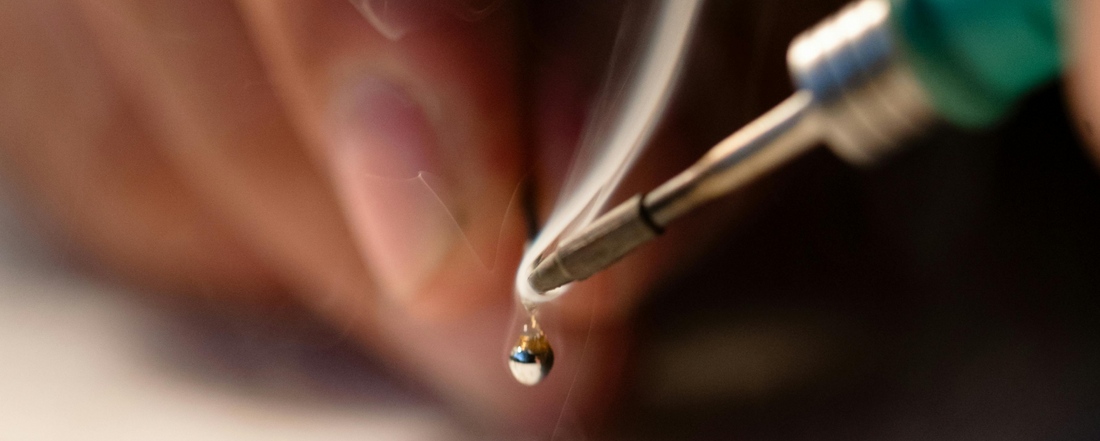
How to Solder Metal
Peter MorrellShare
Soldering is a process that uses melted metal to connect two other pieces of metal. The substance that is being melted, called solder, can be made from one metal or an alloy, with the right type of solder depending on the characteristics of the two objects that are being connected. The solder is melted using a device called a soldering iron. Once the solder cools, it creates a strong bond. This process might seem intimidating at first, but it's really quite simple once you get acquainted with the basics.
What Tools Are Needed?
The primary tool that's needed to do soldering is a soldering iron. Beginners will usually start with a pen-style soldering iron, which is more familiar and comfortable to hold than gun-style soldering irons. It's also a good idea to have a holder for your soldering iron; the tip can reach temperatures of up to 896 degrees, so you need to be very careful not to touch it to anything you're not soldering while it's hot. Soldering irons have interchangeable tips, so you may need more than one depending on what you're working on. Chisel-shaped tips are best for bigger components like wires, while conical tips are easier to use for more precise tasks like soldering circuit boards or a broken gold bracelet. You should also keep a sponge handy to remove oxidation from the tip. And of course, you'll need the right solder for the job.
- Five Things to Consider Before Buying a Soldering Iron
- The Five Essential Tools for Soldering
- Choosing Your Solder
- How to Solder Electronic Components
- Soldering: What You Need to Succeed
Soldering Safely
The most important part of soldering safety is making sure that the hot tip of your soldering iron doesn't touch anything that it's not supposed to. Ideally, you should keep it in a soldering iron holder, but if you don't have one, pay very close attention to where your iron is and what the tip is near at all times. You should also ensure that there's adequate ventilation in your working area; some types of solder can give off toxic fumes when they're heated. In addition, you should wear goggles to protect your eyes from fumes and from the possibility of getting solder in your eyes if it should "spit" while you're working with it. Also, when you're doing soldering, unplug the iron and then go wash your hands: Solder can contain lead, and washing up after you solder ensures that you don't end up ingesting lead particles later on.
- Safe Soldering Work Practices
- Rules for Soldering Safely
- Soldering Safety Guidelines
- Soldering Safety
- Soldering Safety Precautions
Common Electronic Components
Printed circuit boards are among the most commonly soldered objects. Solder is used to attach a variety of components to circuit boards, including resistors, capacitors, switches, transformers, diodes, transistors, and integrated circuits.
- Components Used in Electronics
- 14 Essential Electronic Components and Their Functions
- Basic Electronics
Prepping
Before you start soldering, you need to prepare your workspace and the materials you'll be working with. Start by placing the soldering iron in its holder and plugging it in. Then, make sure your solder and the items to be soldered are close at hand. Clean your items with isopropyl alcohol to remove any contaminants. Once the soldering iron is hot, carefully clean its tip with a wet sponge or a brass scrubber to remove any old solder. Then, it's ready to be tinned.
- Preparation for Soldering and Component Removal
- How to Remove Oxidation From Your Solder Tips
- How to Clean a Circuit Board
Tinning
Tinning is the process of coating the tip of a soldering iron with solder. This helps the heat to transfer more quickly to what you're soldering. To do this, make sure that the tip is up to temperature, then touch the solder to the tip and let it flow on, taking care to get an even coating.
- How to Keep Your Soldering Tip in Good Condition
- How to Look After Soldering Iron Tips
- How to Tin a Soldering Iron
Soldering and De-Soldering
Soldering starts with positioning the two components where you want them, then heating them up using the soldering iron. Once the two pieces are hot enough to melt the solder, touch the solder to them and let it flow into the joint. Keep the soldering iron near the joint so it stays hot. Once the joint is filled in, take away the solder and then the soldering iron. Keep the components still as they cool. If you make a mistake and need to redo a joint, you can remove the solder in a process called de-soldering. To do this, place a piece of soldering braid over the joint, then use your soldering iron to heat up the braid. The heat will melt the solder, and the solder will flow onto the braid. You can also heat the solder directly with your soldering iron and then use a de-soldering pump to suck it out of the joint.
- Fundamentals of Soldering
- Basic Soldering Guide
- The Four Best Ways to De-Solder Electronic Components
- The Essential Guide to De-Soldering
- How to Use a De-Soldering Pump
Cleanup
When you're finished with your soldering project, tin the tip of your soldering iron again, then unplug it, place it in its holder, and let it cool. This extra layer of solder will help to protect the soldering iron tip from oxidation. Then, wash your hands well with soap and water to remove any solder residue.
Tips and Tricks
One of the best ways to ensure that your soldering project goes smoothly is to make sure that you have the right tools for the job. This means choosing the right soldering tip size and shape for what you're working on as well as the right solder; the copper-tin solder used for plumbing is a lot different from the acid-core solder used for gutters or the gold solder used for gold jewelry. You should also make sure to let each solder job cool naturally in order to get a strong joint. Never blow on the solder in an effort to cool it down faster; if it cools too quickly, it will become brittle. And remember not to get frustrated if your joint doesn't come out right. You'll get better with practice, and you can always de-solder a joint and fix it if something goes wrong.
- How to Solder: Tools, Tips, and Tricks to Get You Started
- Nine Essential Electronics Soldering Tips and Tricks for Beginners
- Soldering Tips
More Information on Circuits and Soldering
- How to Solder: A Beginner's Guide: Learn more about the basics of soldering, from the tools you'll need to the technique for connecting components to a circuit board.
- A Simple Guide to Soldering: It's surprisingly easy to learn how to solder, and you don't need a lot of equipment to do it.
- A Weapon of Technology: The Soldering Gun: An inventor in the early 1940s became frustrated with how fast his soldering iron heated up, and he solved this problem by inventing the soldering gun.
- How to Solder: Through-Hole Soldering: Through-hole soldering is a common technique used when assembling electronics.
- How to Remove Solder Without a Soldering Iron: If you've misplaced your soldering iron and find a stray piece of solder that you need to remove, there is a way to work around this problem.
- Soldering Irons and How to Use Them: Watch the videos on this page to learn more about how to solder.
- Six Steps for Soldering Jewelry: Soldering is commonly used to assemble and repair rings and bracelets.
- 13 Top Tips for Successful Soldering: Here are some ways that soldering can go wrong and how to avoid them.
- How to Assemble and Solder Components on a Custom Circuit Board: Once you master the basics of soldering, you can start building all sorts of electronics from scratch.
- Six Common Soldering Problems and How to Fix Them: If you make a mistake while soldering, it's almost always fixable.

Peter Morrell
Learn More